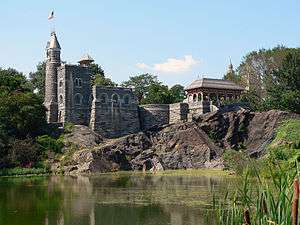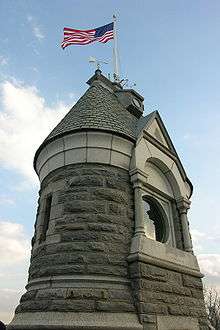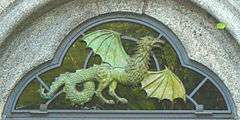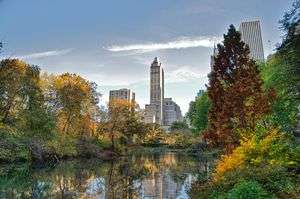Belvedere Castle
Coordinates: 40°46′46″N 73°58′09″W / 40.779447°N 73.96906°W

Belvedere Castle is a folly in Central Park in Manhattan, New York City. It contains exhibit rooms and an observation deck, and since 1919, the folly has also been the location of the official Central Park weather station.[1]
Belvedere Castle was designed by Frederick Law Olmsted and Calvert Vaux in the late 19th century. An architectural hybrid of Gothic and Romanesque styles, Vaux's design called for a Manhattan schist and granite structure with a corner tower with conical cap, with the existing lookout over parapet walls between them.[note 1] To reduce costs it was revised in November 1870 and completed under the Tammany Hall regime as an open painted-wood pavilion.[2]
Belvedere means "beautiful view" or "panoramic view" in Italian.
Design

Belvedere Castle was originally built as a shell with open doorway and window openings. Starting in 1919, it housed the New York Meteorological Observatory, which had been taken over by the United States Weather Bureau in 1912. The current weather station in Central Park, an Automated Surface Observing System (ASOS), is located immediately south of the castle, though wind equipment is still located on the main tower. The main tower was given a more medieval design, with a weather antenna on top, but during the castle's 1983 renovation, the tower was restored to a German style with a flag, a weather vane, and an anemometer on top. The two fanciful wooden pavilions deteriorated without painting and upkeep and were removed before 1900.[3]
The Castle serves now as a visitor center and gift shop. Free family and community programs hosted at Belvedere Castle include birding and other Central Park Conservancy Discovery Programs for families as well as a variety of history and natural history programs led by NYC Urban Park Rangers, including stargazing/astronomy and wildlife-education events.
Originally, the castle faced a rectangular receiving reservoir; today, it overlooks Turtle Pond and the Great Lawn.[note 2]
History

Built as a Victorian folly in 1869, the castle caps Vista Rock, an outcropping of schist and the park's second-highest natural elevation.[note 3][5] Constructed of Manhattan schist quarried in the park and dressed with gray granite, it tops the natural-looking woodlands of The Ramble, as seen from the formal Bethesda Terrace. The natural rock was tunneled through for the innovative sunken transverse roadway that still carries commercial and other traffic unobtrusively through the park. In 1867, Calvert Vaux decided to develop this area by building Belvedere Castle on the top of the rock, overlooking the Croton Reservoir.[6][7]
The castle provides impressive views across Central Park and New York City. It was designed as an additional feature of the Central Park "Greensward" plan by the architects Calvert Vaux and Jacob Wrey Mould after they, along with Frederick Law Olmsted, were reappointed to oversee the park's construction in 1865. As the plantings matured, the castle has been obscured from its original intended viewpoint. Its turret is the highest point in the park.[8]
The site, which overlooks the Lower Reservoir, already held a fire tower under the control of the Croton Aqueduct board. In 1867, the board transferred the site to the park, and the fire tower was demolished.[9] After the New York Meteorological Observatory automated its equipment and moved its offices to Rockefeller Center in the 1960s, Belvedere Castle was closed to the public and became an object of much vandalism, neglect and deterioration.[10] The Central Park Conservancy launched a restoration effort and reopened the structure on May 1, 1983, as the Henry Luce Nature Observatory. Soon after its restoration, the building was used as a filming location for Merchant-Ivory's 1984 film The Bostonians, starring Christopher Reeve and Vanessa Redgrave. In the 1970s, before its renovation, its facade was used for exterior shots of the castle where Count von Count lived on the children's television series Sesame Street. In 1995, the Conservancy's Historic Preservation Crew replaced the painted wooden loggia of the castle, working from Vaux's designs, on the granite piers and walls that had survived.
Renovation
The Central Park Conservancy is conducting a second renovation of Belvedere Castle 35 years after the 1983 renovation. Plans include replacing existing doors and windows with double paned glass. When it was last renovated in 1983, the original turret was replaced, the pavilions were rebuilt, and the castle was converted into a visitor center.[1] In addition the Conservancy proposes to construct a new access path to ADA standards from the East Drive.[11] The proposed access path − actually an elevated ramp with parapets − has been criticized as creating an unnecessary wall in a naturalistic park.[12]
References
Notes
- ↑ The design, published in a lithograph, is illustrated in Rosenzweig and Blackmar, 1992, p. 203.
- ↑ The Lower Reservoir was filled in with city building rubble, beginning with spoil from construction of the New York City Subway's IND Eighth Avenue Line (now carrying the A, B, C, and D trains) in the 1930s.
- ↑ Summit Rock, at 83rd Street overlooking Central Park West is higher at 137.5 feet.[4]
Sources
- 1 2 "Belvedere Castle" at NYC Parks Department
- ↑ Rosenzweig and Blackmar, 1992, p. 269f.
- ↑ Ca. 1900 photograph in Barlow 1987:114 illustration.
- ↑ "Vista Rock & Tunnel - Historical Sign". New York City Department of Parks & Recreation. Retrieved 2010-03-04.
- ↑ "Vista Rock". centralpark2000.com. Retrieved 2010-03-04.
- ↑ "Central Park Highlights - Belvedere Castle". New York City Department of Parks & Recreation. Retrieved 2010-03-04.
- ↑ Rock on nyc.gov
- ↑ CityListen Audio Tours, Central Park: An Urban Marvel Archived February 5, 2011, at the Wayback Machine.
- ↑ Rogers, 1987, p. 115.
- ↑ Rosenzweig and Blackmar, 1992, p. 502
- ↑ Landmarks Preservation Commission, Presentation Materials, May 2, 2017.
- ↑ James Barron, "Plan for Inclined Walk in Central Park Worries Preservationists," New York Times, June 11, 2017.
Further reading
- Rogers, Elizabeth Barlow et al., 1987. Rebuilding Central Park: A Management and Restoration Plan (MIT Press for the Central Park Conservancy).
- Rosenzweig, Roy and Elizabeth Blackmar, 1992. The Park and the People: A History of central Park (Cornell University Press)
External links
| Wikimedia Commons has media related to Belvedere Castle. |


.jpg)